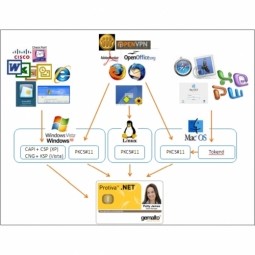Download PDF
When Time is of the Essence: Wroclaw Centre for Networking and Supercomputing Speeds Understanding of Sea Level Change with DDN Storage and Advanced Lustre File Sharing
Technology Category
- Infrastructure as a Service (IaaS) - Cloud Storage Services
Applicable Industries
- Education
- Life Sciences
Applicable Functions
- Product Research & Development
- Quality Assurance
Use Cases
- Predictive Maintenance
- Process Control & Optimization
Services
- Cloud Planning, Design & Implementation Services
- Data Science Services
The Challenge
Wroclaw Centre for Networking and Supercomputing (WCSS) was facing challenges in supporting the processing and collection of increasingly large, complex, data-intensive scientific weather and geographic models. The temporary or scratch storage was required to address data growth across diverse scientific projects. The center needed to deliver access and capacity to support the work of over 3,000 scientists and researchers. There was an escalating need to address mixed workloads across a complicated, heterogeneous ecosystem of hardware and applications.
About The Customer
Wroclaw Centre for Networking and Supercomputing (WCSS) is a unit of the Wroclaw University of Technology. It provides more than 3,000 scientists and researchers at the university and other academic institutions with cutting-edge computational tools and high-performance storage to support a wide range of scientific research. As one of Poland’s five national supercomputing centers, WCSS takes advantage of advanced computing capabilities, including a recently acquired computer cluster that ranks among the 100 fastest computers in the world. This supercomputing power enables WCSS to ensure fast, reliable and secure access to large data files and vast amounts of scientific research. With its highly innovative technology infrastructure, WCSS supports scientific breakthroughs in acoustics, chemistry, informatics, life sciences, mechanics, molecular biology, physics and other scientific disciplines.
The Solution
WCSS implemented DDN’s SFA12KX® family of high-performance storage which delivers industry-leading performance, capacity and density. The DDN EXAScaler® file system ensures ample storage available to all network nodes with fully parallel I/O across clients, servers and storage. The solution also supports Intel® Enterprise Edition for Lustre software to resolve HPC storage and throughput challenges. The robust storage meets needs for shared access to project data from several hundred jobs at the same time. The solution also provided optimized InfiniBand host-port options for delivering seamless connectivity between servers and storage.
Operational Impact
Quantitative Benefit
Related Case Studies.

Case Study
Corporate Identity Solution Adds Convenience to Beckman Coulter
Beckman Coulter wanted to implement a single factor solution for physical and remote logical access to corporate network. Bechman Coulter's users were carrying smart card badges for doors, but also needed a one-time password token to access to our corporate network when they were not in the office. They wanted to simplify the process.

Case Study
IoT platform Enables Safety Solutions for U.S. School Districts
Designed to alert drivers when schoolchildren are present, especially in low-visibility conditions, school-zone flasher signals are typically updated manually at each school. The switching is based on the school calendar and manually changed when an unexpected early dismissal occurs, as in the case of a weather-event altering the normal schedule. The process to reprogram the flashers requires a significant effort by school district personnel to implement due to the large number of warning flashers installed across an entire school district.

Case Study
Embracing Business Success in Real Time
· Increase control over growing Big Data to improve business decisions · Manage data for 28,000 biotechnology stockkeeping units in the fields of microbiology, molecular biology, animal cell cultures, plant tissue cultures, and lab ware for laboratory chemicals · Accelerate report generation and analysis with real-time data

Case Study
Revolutionizing Medical Training in India: GSL Smart Lab and the LAP Mentor
The GSL SMART Lab, a collective effort of the GSL College of Medicine and the GSL College of Nursing and Health Science, was facing a challenge in providing superior training to healthcare professionals. As clinical medicine was becoming more focused on patient safety and quality of care, the need for medical simulation to bridge the educational gap between the classroom and the clinical environment was becoming increasingly apparent. Dr. Sandeep Ganni, the director of the GSL SMART Lab, envisioned a world-class surgical and medical training center where physicians and healthcare professionals could learn skills through simulation training. He was looking for different simulators for different specialties to provide both basic and advanced simulation training. For laparoscopic surgery, he was interested in a high fidelity simulator that could provide basic surgical and suturing skills training for international accreditation as well as specific hands-on training in complex laparoscopic procedures for practicing physicians in India.

Case Study
Implementing Robotic Surgery Training Simulator for Enhanced Surgical Proficiency
Fundacio Puigvert, a leading European medical center specializing in Urology, Nephrology, and Andrology, faced a significant challenge in training its surgical residents. The institution recognized the need for a more standardized and comprehensive training curriculum, particularly in the area of robotic surgery. The challenge was underscored by two independent studies showing that less than 5% of residents in Italian and German residency programs could perform major or complex procedures by the end of their residency. The institution sought to establish a virtual reality simulation lab that would include endourological, laparoscopic, and robotic platforms. However, they needed a simulator that could replicate both the hardware and software of the robotic Da Vinci console used in the operating room, without being connected to the actual physical console. They also required a system that could provide both basic and advanced simulation training, and a metrics system to assess the proficiency of the trainees before they performed surgical procedures in the operating theater.

Case Study
Edinburgh Napier University streamlines long-distance learning with Cisco WebEX
• Geographically dispersed campus made in-person meetings costly and inconvenient.• Distance-learning programs in Malaysia, India, and China required dependable, user-friendly online tools to maximize interaction in collaborative workspaces.• Virtual learning environment required a separate sign-in process, resulting in a significant administrative burden for IT staff and limited adoption of collaboration technology.





